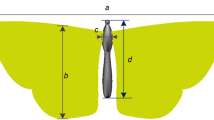Abstract
Mimicking insect flights were used to design and develop new engineering materials. Although extensive research was done to study various aspects of flying insects. Because the detailed mechanics and underlying principles involved in insect flights remain largely unknown. A systematic study was carried on insect flights by using a combination of several advanced techniques to develop new models for the simulation and analysis of the wing membrane and veins of three types of insect wings, namely dragonfly (Pantala flavescens Fabricius), honeybee (Apis cerana cerana Fabricius) and fly (Sarcophaga carnaria Linnaeus). In order to gain insights into the flight mechanics of insects, reverse engineering methods were used to establish three-dimensional geometrical models of the membranous wings, so we can make a comparative analysis. Then nano-mechanical test of the three insect wing membranes was performed to provide experimental parameter values for mechanical models in terms of nano-hardness and elastic modulus. Finally, a computational model was established by using the finite element analysis (ANSYS) to analyze and compare the wings under a variety of simplified load regimes that are concentrated force, uniform line-load and a torque. This work opened up the possibility towards developing an engineering basis for the biomimetic design of thin solid films and 2D advanced engineering composite materials.
Similar content being viewed by others
References
Kesel AB, Philippi U, Nachtigall W. Biomechanical Aspects of the Insect Wing: An Analysis Using the Finite Element Method[J]. Comput. Biol. Med., 1998, 28: 423–437
Combes SA, Daniel TL. Flexural Stiffness in Insect Wings I. Scaling and the Influence of Wing Venation[J]. J. Exp. Biol., 2003, 206: 2979–2987
Ganguli R, Gorb S, Lehmann FO, et al. An Experimental and Numerical Study of calliphora Wing Structure[J]. Exp. Mech., 2010, 50: 1183–1197
Sunada S, Zeng LJ, Kawachi K. The Relationship between Dragonfly Wing Structure and Torsional Deformation[J]. J. Theor. Biol., 1998, 193: 39–45
Kesel AB. Aerodynamic Characteristics of Dragonfly Wing Sections Compared with Technical Aerofoils[J]. J. Exp. Biol., 2000, 203: 3125–3135
Zhou SZ, Wang R. The Development of Functional Materials[J]. J. Funct. Mater., 1990, 21: 198-200, 206
Bao XQ, Bontemps A, Grondel S, et al. Design and Fabrication of Insect-inspired Composite Wings for MAV Application Using MEMS Technology[J]. J. Micromech. Microeng., 2011, 21: 125 020
Li ZX, Shen W, Tong GS, et al. On the Vein-stiffening Membrane Structure of a Dragonfly Hind Wing[J]. J. Zhejiang Univ. Sci. A, 2009, 10: 72–81
Yadav M. Biology of Insects [M]. Beijing: Discovery Publishing House Press, 2003
Machida K, Shimanuki J. Structure Analysis of the Wing of a Dragonfly [C]. In: Microtechnologies for the New Millennium 2005, Bellingham, 2005: 671–676
Machida K, Oikawa T. Structure Analyses of the Wings of anotogaster sieboldii and hybris subjacens[J]. Key Eng. Mater., 2007, 345-346: 1237–1240
Wang XS, Li Y, Shi YF. Effects of Sandwich Microstructures on Mechanical Behaviors of Dragonfly Wing Vein[J]. Compos. Sci. Technol., 2008, 68: 186–192
Jongerius SR, Lentink D. Structural Analysis of a Dragonfly Wing[J]. Exp. Mech., 2010, 50: 1323–1334
Ahearne M, Yang Y, Then K, et al. An Indentation Technique to Characterize the Mechanical and Viscoelastic Properties of Human and Porcine Corneas[J]. Ann. Biomed. Eng., 2007, 35: 1608–1626
Sun JY, Bhushan B. The Structure and Mechanical Properties of Dragonfly Wings and Their Role on Flyability[J]. CR. Mecanique, 2012, 340: 3–17
Tong J, Zhao YR, Sun JY, et al. Nanomechanical Properties of the Stigma of Dragonfly Anax Parthenope Julius Brauer[J]. J. Mater. Sci., 2007, 42: 2894–2898
Vincent JFV, Wegst UGK. Design and Mechanical Properties of Insect Cuticle[J]. Arthropod. Struct. Dev., 2004, 33: 187–199
Song F, Xiao KW, Bai K, et al. Microstructure and Nanomechanical Properties of the Wing Membrane of Dragonfly[J]. Mater. Sci. Eng. A, 2007, 45: 254–260
Author information
Authors and Affiliations
Corresponding author
Additional information
Funded by the National Natural Science Foundation of China (Nos. 31172144, 51475204), the National Science & Technology Pillar Program of China in the Twelfth Five-Year Plan Period (2014BAD06B03), the Exchange Projects of the Royal Academy of Engineering, UK (Major Award, 2010-2011), and the “Project 985” of Jilin University
Rights and permissions
About this article
Cite this article
Tong, J., Chang, Z., Yang, X. et al. Nanoindentation mechanical properties and structural biomimetic models of three species of insects wings. J. Wuhan Univ. Technol.-Mat. Sci. Edit. 30, 831–839 (2015). https://doi.org/10.1007/s11595-015-1238-y
Received:
Accepted:
Published:
Issue Date:
DOI: https://doi.org/10.1007/s11595-015-1238-y




